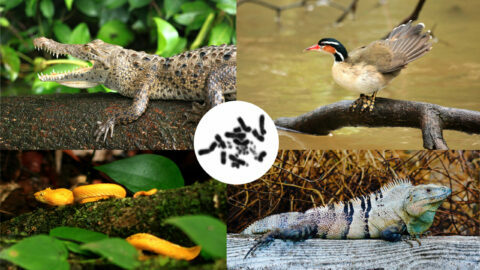Microchromosomes: genomic evidence of the origin of vertebrate chromosomes
Microchromosomes are essential components of the chromosomes of extant vertebrates, including mammals, as they have fused and reorganised from a common ancestor to form the chromosomes present in current species. This has been demonstrated now by an international study with the involvement of the UAB that traced the origin and destination of microchromosomes in birds, reptiles and mammals, and identified chromosomal structures present in the origin of vertebrates at least 500 million years ago. The results of the research, published in the journal PNAS, represent a breakthrough in the study of the origin and function of genome organisation.

Microchromosomes are tiny chromosomes that make up the genomes of birds, some reptiles and fish, but are absent in mammals. Initially considered irrelevant, studies conducted so far have found them to be rich in highly conserved genes, suggesting that they might be present in the common ancestor of all vertebrates.
An international team of researchers, with the involvement of Aurora Ruiz-Herrera and Lucía Álvarez from the Universitat Autònoma de Barcelona (UAB), recently identified in a study published in the prestigious journal PNAS the common chromosomal components present in the origin of vertebrates more than 500 million years ago. This has allowed unravelling the origin of microchromosomes and their evolutionary patterns in birds, reptiles and mammals. The results show that far from being aberrant genetic elements, microchromosomes represent the fundamental building blocks of vertebrate chromosomes, including mammals. According to researchers, this study, conducted through the computational analysis of the genomes of 21 vertebrate species, represents a breakthrough for our understanding of the origin and function of the organisation of genomes.
The UAB researchers participating in the study: Lucía Álvarez (left) and Aurora Ruiz-Herrera, director of the Animal Genomics research group at the UAB. Author: Laia Marín.
The origin of vertebrates dates back at least 500 million years to the Palaeozoic era, from the first fish that were able to develop an internal cartilaginous skeleton. From then on, species evolved to form today’s great diversity of fish, birds, reptiles and mammals that inhabit the planet.
Curiously, the genomes of birds and reptiles are made up of two types of chromosomes of very different sizes (microchromosomes and macrochromosomes), unlike mammals, which have chromosomes that are all of similar sizes, medium-sized when compared to the rest of vertebrates. “The origin of such differences has intrigued the scientific community since they were initially described in the middle of the past century”, explains Aurora Ruiz-Herrera, Associate Professor of the Department of Cell Biology, Physiology and Immunology and the Institute of Biotechnology and Biomedicine (IBB) at the UAB, and co-author of the study. “Initially considered as fragments of the genome without any relevance, the study shows that microchromosomes are, in fact, highly conserved between birds and reptiles, suggesting a common functional origin”, says the researcher.
In fact, the microchromosomes of birds and reptiles share sequence homology with one or more of the tiny chromosomes present in an invertebrate that diverged from the common ancestor of vertebrates at least 500 million years ago”, explains Lucía Álvarez, researcher at the Animal Genomics Group, coordinated by Aurora Ruiz-Herrera, and co-author of the paper. “In mammals, however, microchromosomes have disappeared to reorganise themselves and form new chromosomes present in current species”, she continues.
The study concludes that microchromosomes characteristic of birds represent the remains of the original basic components of the vertebrate genome. Microchromosomes retain a high density of genes and a low content of repetitive sequences, and share characteristics conserved in all phylogenetic groups of reptiles and birds. In most reptile lineages, microchromosomes progressively and gradually fused with macrochromosomes. However, early in mammalian evolution, multiple microchromosome fusions occurred, followed by abrupt lineage-specific genome rearrangements.
“The comparative study of the genomes of different species shows that mammals (including humans) without microchromosomes, are in fact the exception to the rule among vertebrates”, concludes Aurora Ruiz-Herrera.
The study has been led by research teams from La Trobe University and UNSW Sydney, with the involvement of the Australian National University, University of Canberra, University of Adelaide, Universitat Autònoma de Barcelona and University of Vienna.
Article: Waters et al., Microchromosomes are building blocks of bird, reptile, and mammal chromosomes. Proc. Natl. Acad. Sci. U.S.A., doi:10.1073/pnas.2112494118 (2021). https://www.pnas.org/content/118/45/e2112494118